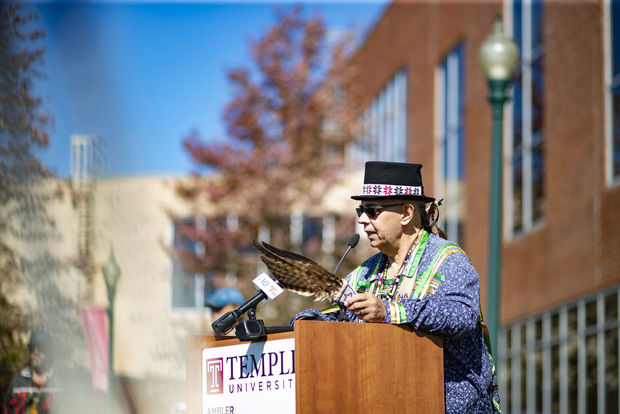Tyler School of Art and Architecture Issues Formal Land Acknowledgment

The Collegial Assembly at Tyler School of Art and Architecture recently adopted use of an Indigenous Land Acknowledgment, developed by a faculty committee spearheaded by Art History Chair Jane DeRose Evans, to recognize the history of the native peoples who originally lived on the lands where the school sits.
In practice, the Land Acknowledgment can be voluntarily used before public events held on campus to encourage both event planners and visitors to think deeper about the work that is done both in and out of the classroom and how it is connected to the land that we inhabit.
The effort to craft a relevant Land Acknowledgment for the school emerged from an ongoing conversation within the Art History Department about what it means to rethink the history of art as a whole. Accordingly, the use of a Land Acknowledgment was viewed as something that should be actively incorporated into the Tyler identity.
Evans gathered information from faculty members, talked with Tyler Dean Susan E. Cahan, and researched how other major institutions frame their Land Acknowledgments, commonly used in the West and Midwest. Evans also attended several workshops where Indigenous speakers addressed the complexities of Land Acknowledgments and explained their meaning.
Evans recalled particularly that one speaker said, “Land Acknowledgments are great, but it’s as if I was sitting out in the hot sun with a bottle of water, and you walk over to me and take it and say, ‘I acknowledge that I’ve taken your bottle of water.’” To that effect, Evans wanted to make sure that Tyler’s statement encouraged awareness, and actions one could take to foster connection with Indigenous people.
Following last fall’s tornado, which caused immense damage to Temple’s Ambler campus, Kathy Salisbury, Director of the Ambler Arboretum, reached out to members of the Lenape tribe to host a healing ceremony for the land, nature, and lives that had been lost.
Following the ceremony, Salisbury said she hopes that the growing relationship with the Lenape tribe encourages awareness of the stories that the land has to tell, both at Ambler and main campus. Salisbury hopes to incorporate interpretive signage around Ambler’s campus that sheds light on its Indigenous history.
Salisbury introduced Evans to Adam DePaul, a Lenape storyteller who addressed Tyler’s Collegial Assembly, and afterward appreciated the thoughtfulness of the language in the final statement.
DePaul spoke to his experience working with Tyler, saying, “I feel that Tyler is doing this in the right way. The first thing that Tyler did right was come to us and ask us what we thought about it. That’s the way to do it, to work in collaboration with the native community. All the folks really seemed genuinely interested in the land acknowledgment, and it didn’t seem like just a box that the campus was checking off. The best thing is that we left on a note that the land acknowledgment is the first step toward further collaboration and building a relationship between our nation and the campus. All of those things are what make a land acknowledgment successful.”
Moving forward, Evans hopes that Tyler’s Land Acknowledgment will help to accurately convey the school’s values and “a sense of who we are” when people come to events, tour the building, or take classes. She hopes that people deeply think about the implications of colonialism and strengthen Tyler’s relationship with the Lenape people as well as other disenfranchised groups.